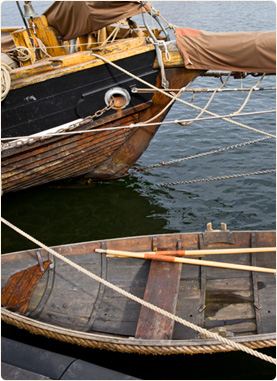
Why The Name Phoenicia?
Phoenicians Spread Trade and Civilization
About 1100 B.C., after Crete’s decline, the most powerful traders along the Mediterranean were the Phoenicians . Phoenicia was mainly the area now known as Lebanon. Phoenicians never united into a country. Instead, they founded a number of wealthy city-states around the Mediterranean that sometimes competed with one another. The first cities in Phoenicia, such as Byblos, Tyre, and Sidon, were important trading centers.
The Phoenicians were remarkable shipbuilders and seafarers. They were the first Mediterranean people to venture beyond the Strait of Gibraltar. Some scholars believe that the Phoenicians traded for tin with inhabitants of the southern coast of Britain. Some evidence exists for an even more remarkable feat—sailing around the continent of Africa by way of the Red Sea and back through the Strait of Gibraltar. Such a trip was not repeated again for 2,000 years.
Commercial Outposts Around the Mediterranean
The Phoenicians’ most important city-states in the eastern Mediterranean were Sidon and Tyre, both known for their production of red-purple dye, and Byblos, a trading center for papyrus. Phoenicians built colonies along the northern coast of Africa and the coasts of Sicily, Sardinia, and Spain. The colonies were about 30 miles apart— about the distance a Phoenician ship could sail in a day. The greatest Phoenician colony was at Carthage , in North Africa. Settlers from Tyre founded Carthage in about 814 B.C. The Phoenicians traded goods they got from other lands—wine, weapons, precious metals, ivory, and slaves. They also were known as superb craftspeople who worked in wood, metal, glass, and ivory. Their red-purple was produced from the murex, a kind of snail that lived in the waters off Sidon and Tyre. One snail, when left to rot, produced just a drop or two of a liquid of a deep red-purple color. Some 60,000 snails were needed to produce one pound of dye, which only royalty could afford.
Phoenicia’s Great Legacy: The Alphabet As merchants, the Phoenicians needed a way of recording transactions clearly and quickly. So, the Phoenicians developed a writing system that used symbols to represent sounds. The Phoenician system was phonetic— that is, one sign was used for one sound. In fact, the word alphabet comes directly from the first two letters of the Phoenician alphabet: aleph and beth. As they traveled around the Mediterranean, the Phoenicians introduced this writing system to their trading partners. The Greeks, for example, adopted the Phoenician alphabet and changed the form of some of the letters.

